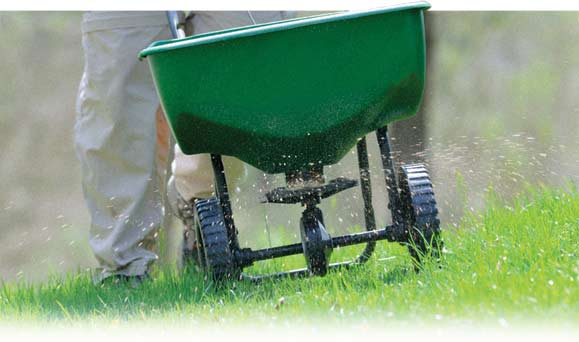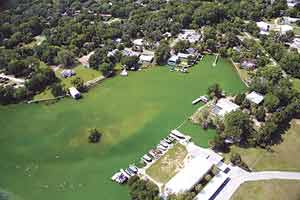
The District recently kicked off a new multimedia public service advertising campaign to educate residents on Florida-friendly fertilizing.
“There are a lot of misconceptions about how to fertilize properly,” said Virginia Sternberger, senior communications coordinator in the District’s Public Education Section. “For example, some residents think that if a little fertilizer will help their lawns, a lot will be even better. Some think that the best time to fertilize is just before it rains. We’re hoping to educate people on the right way to fertilize.”
“We are likely to see the legacy of our current fertilizing habits affecting springs for decades to come.”
— District scientist Gary Williams
Called “Florida-Friendly Fertilizing,” the three-month campaign is designed to increase District residents’ knowledge about proper fertilizing. Sternberger hopes the campaign will change the way District residents fertilize — for the better.
“Many people don’t know when to fertilize, how much to buy, how to read a fertilizer label and select the right fertilizer for their soil type, how much to apply, and how much water is needed to water-in the fertilizer,” said Sternberger. “People I talk to are often surprised to learn there is a connection between fertilizer use and algae in their local water bodies.”
Nitrates and Algae
Recent studies have shown that rising nitrate levels in many local water bodies can be traced to fertilizer. Nitrate is a form of nitrogen that is found in inorganic fertilizers. When fertilizer is needed and applied correctly, the lawn absorbs the nitrogen. However, fertilizers applied improperly can run off lawns and into local water bodies, harming water quality and threatening the plants and animals that depend on clean water for survival.
Gary Williams, a District senior environmental scientist, has seen the results of high nitrate levels affecting water quality.
“Fertilizer makes plants grow, but increased nitrate levels in rivers can cause algae to grow out of control,” said Williams. “In the spring-fed rivers in the District’s northern region, increases in nitrate levels have generally been followed by large increases in the amount of algae in these systems.”

An algal bloom colors the water near Hunter’s Spring in Crystal River in this May 2008 photo.
Algal blooms have been a particular problem in Citrus County’s Crystal River/Kings Bay, one of the District’s priority water bodies. Williams said that heavy rain can wash fertilizer into water bodies, feeding the algae problem.
“Lawns usually accumulate decayed plant material during the dry season, which is a natural source of nutrients,” said Williams. “If you add fertilizer and a heavy rain event to the mix, all those nutrients can wash into water bodies, basically creating a buffet line for the algae.”
Nutrients that soak into the ground, but are not used by lawns, can also create problems, according to Williams. They can pollute the aquifer.
“Once nitrate gets below the landscape’s root zone, it will stay in the groundwater,” said Williams. “There is nothing in the aquifer that will naturally bind to it or use it up.”

Fertilizing how-to videos are online that address these topics:
- How fertilizing can impact the environment
- How do you know if your grass needs fertilizer?
- When should you apply fertilizer if it is needed?
- How much fertilizer should you buy?
- How to read a fertilizer bag and choose a fertilizer
- How to apply fertilizer
- Proper lawn maintenance
In many of the District’s areas, especially in the north, the nitrates will later emerge from springs.
“Water coming out of a spring may be a few months old or may have been in the aquifer for years,” said Williams. “Because of the time lag between recharge and discharge, we are likely to see the legacy of our current fertilizing habits affecting springs for decades to come.”
 Read the Label
Read the Label
Always follow package directions to avoid over-fertilizing.
 Choose Slow-Release Fertilizer
Choose Slow-Release Fertilizer
It takes longer for your yard to benefit from slow-release nitrogen, but the effects will last longer.
 Fertilize When Grass Is Actively Growing
Fertilize When Grass Is Actively Growing
Fertilizer applied when grass is not growing wastes money and time.
 Don’t Fertilize Before a Heavy Rain
Don’t Fertilize Before a Heavy Rain
Lawns need only ¼ inch of water after each fertilizer application.
The District’s northern areas aren’t the only places where fertilizers can pollute water bodies.
“Increased nitrogen levels have been a challenge in Tampa Bay, one of our priority water bodies,” said Veronica Craw, District Environmental Section manager. “The Tampa Bay Estuary Program reports that 20 percent of the nitrogen load to Tampa Bay can be attributed to residential runoff, including fertilizer residue.”
According to Sternberger, educating the public is one way to reduce nitrates in area water bodies.
“We can help protect water quality and still have beautiful lawns,” said Sternberger. “We just need to take a few steps to be sure that if we’re fertilizing, we are doing it the right way.”
The District has created a series of tools to help residents learn to apply fertilizer appropriately. By visiting WaterMatters.org/fertilizing, residents can get step-by-step instructions on fertilizing appropriately as well as watch a series of how-to videos. Residents can also order the free 20-page “A Do-It-Yourself Guide to Florida-Friendly Fertilizing” for additional information.
